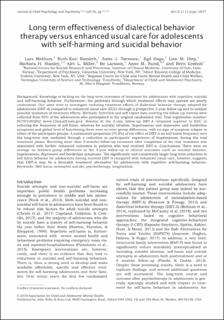Long term effectiveness of dialectical behavior therapy versus enhanced usual care for adolescents with self-harming and suicidal behavior
Mehlum, Lars; Ramleth, Ruth-Kari; Tørmoen, Anita Johanna; Haga, Egil; Diep, Lien My; Stanley, Barbara; Miller, Alec L.; Larsson, Bo Sture; Sund, Anne Mari; Grøholt, Berit
Peer reviewed, Journal article
Accepted version

View/
Date
2019Metadata
Show full item recordCollections
Original version
Journal of Child Psychology and Psychiatry and Allied Disciplines. 2019, 60 (10), 1112-1122. 10.1111/jcpp.13077Abstract
Background
Knowledge is lacking on the long‐term outcomes of treatment for adolescents with repetitive suicidal and self‐harming behavior. Furthermore, the pathways through which treatment effects may operate are poorly understood. Our aims were to investigate enduring treatment effects of dialectical behavior therapy adapted for adolescents (DBT‐A) compared to enhanced usual care (EUC) through a prospective 3‐year follow‐up and to analyze possible mediators of treatment effects.
Methods
Interview and self‐report data covering the follow‐up interval were collected from 92% of the adolescents who participated in the original randomized trial. Trial registration number: NCT01593202 (www.ClinicalTrials.gov).
Results
At the 3‐year follow‐up DBT‐A remained superior to EUC in reducing the frequency of self‐harm, whereas for suicidal ideation, hopelessness and depressive and borderline symptoms and global level of functioning there were no inter‐group differences, with no sign of symptom relapse in either of the participant groups. A substantial proportion (70.8%) of the effect of DBT‐A on self‐harm frequency over the long‐term was mediated through a reduction in participants’ experience of hopelessness during the trial treatment phase. Receiving more than 3 months follow‐up treatment after completion of the trial treatment was associated with further enhanced outcomes in patients who had received DBT‐A.
Conclusions
There were on average no between‐group differences at the 3‐year follow‐up in clinical outcomes such as suicidal ideation, hopelessness, depressive and borderline symptoms. The significantly and consistently larger long‐term reduction in self‐harm behavior for adolescents having received DBT‐A compared with enhanced usual care, however, suggests that DBT‐A may be a favorable treatment alternative for adolescents with repetitive self‐harming behavior.